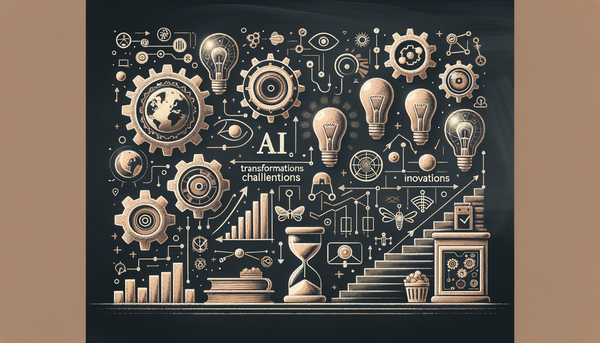Asia’s Economic Landscape: Navigating Tariffs and AI Innovations
This piece explores the dynamic interplay between innovative consumer technology and an unprecedented surge in artificial intelligence momentum across Asia. We journey from Nothing’s playful yet robust mobile devices that bring style and functionality to the fore, to the high-energy AI revolution spearheaded by DeepSeek fueling China’s National People’s Congress. Alongside, we examine the record-breaking investments by mainland Chinese in Hong Kong’s tech stocks and discuss the broader implications for Asia’s financial landscape amidst tariff vulnerabilities. In doing so, we unearth the remarkable synthesis of aesthetic design, economic strategy, and technological advancement that is reshaping the region.
Bridging Aesthetics and Affordability: The Nothing Phone 3A and 3A Pro
The tech world has long been enamored with the idea that high performance must come at an exorbitant price, but Nothing’s launch of the Phone 3A and 3A Pro challenges that notion head-on. These devices provide a sublime blend of playful design and advanced technology, hearing the cries of a generation that desires both innovation and affordability.
At first glance, the Nothing Phone 3A catches the eye with its dazzling LED accents, famously called Glyph. This design ethos embodies minimalism while adding a splash of color and fun—qualities that set these phones apart from the typical polished, corporate aesthetics of industry heavyweights. The device, starting at around $379, proves that you don’t have to compromise on style to deliver solid performance. The 6.7-inch bright display, running on a Qualcomm Snapdragon 7s Gen 3 processor paired with up to 12GB of RAM, is designed to cater to the needs of tech enthusiasts who demand seamless multitasking and vibrant display quality.
The Nothing Phone 3A Pro offers a more elevated experience, particularly for photography aficionados. Equipped with an advanced camera setup featuring a robust 50-megapixel sensor complemented by enhanced zoom capabilities, users can experience a new level of mobile photography—a feature that might entice those passionate about capturing everyday moments in striking detail. An innovative feature like Essential Space, which functions as a personal hub for notes and snapshots, highlights how software can augment hardware, transforming a simple mobile product into a smart personal assistant.
This new generation of Nothing phones reaffirms that technological advancement doesn’t have to come at a premium cost. In fact, the approach taken by Nothing is to democratize technology; rather than being available only to those who can afford the latest flagship devices, these phones are designed to bridge the gap between elegance, performance, and a friendly price point. One might even say these devices are a testament to the idea that innovation can be both accessible and stylish.
Historical references remind us that every technological leap—whether in the personal computer, the smartphone, or the microprocessor—often started as radical reimaginings of what was previously thought possible. The Nothing Phone series, with its playful design and standout features, is no different as it champions a future where technology is not only highly functional but also inherently delightful to use.
DeepSeek and the AI Renaissance: Energizing China's National Forum
Turning our attention to the realm of artificial intelligence, this period marks an extraordinary transformation in China’s approach to AI, as showcased during the latest session of the National People’s Congress (NPC). A significant highlight of the event was the high-profile presence of DeepSeek, a local startup whose groundbreaking work has ignited a fervor across policy, investment, and technology sectors alike.
Historically, the NPC has been a stage for formal and measured debates; however, this session was noticeably charged with enthusiasm over AI’s potential. Emerging from this dynamic atmosphere was a consensus that artificial intelligence could be the cornerstone for future economic growth and societal transformation. For instance, during an insightful press conference where top economic officials delineated the future of China’s tech paradigm, it was noted that strict emphasis on AI was setting the stage for a historic evolution in how technology can enhance regional identities and economic strategies.
"The pace of progress in artificial intelligence is incredibly fast." – Elon Musk
This sentiment resonates deeply in the context of DeepSeek's efforts. By challenging the status quo, DeepSeek has turned traditional expectations on their head, creating a ripple effect that has manifested in soaring market responses and a flurry of new policy proposals. The spirit of innovation that DeepSeek embodies has percolated through every level of the NPC discussions, laying out ambitious plans such as enhancing AI education, ramping up application-driven research, and refining regulatory frameworks to nurture this revolutionary field.
The infusion of a massive 1 trillion yuan state-backed fund dedicated to AI and quantum technology signals more than just an investment—it is a bold declaration of intent. Coupled with similar trends observed in other emerging technologies like solar energy and electric vehicles, these efforts indicate a robust, multidimensional thrust towards harnessing new technologies for broader socioeconomic benefit.
This kind of policy shift is reminiscent of historical periods where intense national focus on innovation led to significant leaps in both technology and economic maturity. In many ways, China’s renewed focus on AI, spurred by startups like DeepSeek, mirrors the transformation seen during the early phases of the computer revolution, a time when groundbreaking ideas began to reshape entire industries.
The competitive spirit emerging from various provinces such as Guangdong and Wuhan underlines the regional aspiration to become the next epicenters of AI advancement. With territories actively vying for leadership and investment, the NPC’s vibrant discourse suggests an environment that is not just reactive, but proactively transformational. It is a scenario where decentralization of innovation is gaining foothold alongside improved coordination in deploying resources, with local governments carving out niches for specialized technological growth.
Mainland Chinese Investors: Catalysts in Hong Kong’s Tech Overhaul
Closely linked to the AI fervor in China is the dramatic movement of mainland Chinese investors into Hong Kong’s equity markets. Recent reports have confirmed that investors are snapping up Hong Kong stocks at an unprecedented pace, with an impressive 29.62 billion Hong Kong dollars (approximately $3.81 billion) being funneled into the market. This dynamic shift underlines not just the regional optimism surrounding tech but also the broader strategic reallocation of capital towards innovation and growth.
The tech sector, and specifically the tech-focused Hang Seng Index, has become a litmus test for investor sentiment. While many global markets contend with various economic pressures, Hong Kong has emerged as a beacon for secure investments, buoyed by investments in emerging technology. Giants like Alibaba and Tencent, known for their dominant digital ecosystems, are at the forefront of these investments, reflecting a clear market preference for companies that are poised to benefit from technological breakthroughs in AI and beyond.
This overwhelming investor enthusiasm is not isolated. It interlinks with broader economic measures, such as an improved fiscal deficit and strategic subsidies aimed at fostering private tech innovation. Collectively, these factors have culminated in renewed confidence among investors, signaling that the groundwork for a future tech renaissance in Hong Kong has been firmly laid. Notably, these developments can also be cross-referenced with insights from our ongoing discussions on the topic at Mainland Chinese Investors Make Waves in Hong Kong's AI Stock Market.
If one were to draw a parallel, it might be compared to the early days of the dot-com boom, when digital investments triggered a massive reevaluation of market potential in technology sectors. Although the current landscape is tempered by a mix of caution and calculated risk-taking, the aggressive foray into Hong Kong stocks has the potential to catalyze wider economic benefits across the region.
The strategic shift also offers broader lessons for how investment patterns are evolving. Traditional sectors are being reexamined under the lens of technology, with a renewed focus on growth catalysts like AI. It's a scenario that reinforces the notion that market participants are increasingly willing to invest in the future, rather than just the present, paving the way for robust economic shifts that extend well beyond short-term gains.
Asia Stocks: Tariff Vulnerabilities Amidst the AI-Driven Upside
While the spotlight has been on the leaps in technological innovation and investment, the broader context across Asia remains complex. Many Asian stock markets are currently navigating vulnerabilities triggered by global tariff pressures. Yet, even amidst these challenges, the infusion of artificial intelligence remains a potential game changer, offering pathways towards growth even in precarious economic conditions.
Goldman Sachs and other financial institutions have recently weighed in on the idea that despite tariff-induced uncertainties, the prospects for AI-driven growth in Asia are promising. Given that traditional sectors are still grappling with the disruptive impacts of global trade policies, there is a definitive belief that AI can serve as an important lever—transforming industries, accelerating efficiencies, and even opening up new revenue streams.
The concept here isn’t just about implementing AI for the sake of technological novelty; it’s about reshaping entire economic paradigms. Consider an environment where AI algorithms optimize supply chains, enhance customer experience through personalized recommendations, and even forecast market trends with impressive accuracy. In such scenarios, AI can effectively neutralize some of the adverse impacts that tariffs might otherwise impose on the economy.
Moreover, the influence of AI-driven transformation doesn’t stop at economics. Enhanced productivity through automation and advanced analytics is already reverberating across industries, from manufacturing to healthcare. Frontline examples include smart factories that utilize machine learning to reduce waste and streamline production—a modern echo of the industrial revolutions that once redefined manufacturing around the globe.
This potential for reinvention is a recurring theme in our exploration of AI’s broader impact. If investors and policymakers can harness AI’s capabilities effectively, we might witness a significant shift where technology-driven growth not only mitigates existing vulnerabilities but also sets the stage for next-generation economic paradigms. Readers may also find additional insights on this topic at our article Asia's Financial Landscape: Vulnerabilities and AI's Potential.
Interconnections and Broader Reflections on the Role of Innovation
Connecting the dots between consumer technology, public policy, and financial markets reframes our understanding of technological influence in a comprehensive way. On the one hand, we see playful consumer devices like the Nothing Phone 3A and 3A Pro that elevate user experience with a vibrant mix of design and functionality. On the other hand, the AI sector in China is undergoing rapid changes catalyzed by visionary startups and resolute governmental commitments, fueling not only policy shifts but also preferential capital flows across borders.
Such a synergy between seemingly disparate sectors is not unprecedented. Throughout history, transformative technologies have often sparked widespread economic and social shifts. In the early 20th century, the spread of electrification radically transformed industries and consumer expectations alike. Today, artificial intelligence and advanced consumer electronics are redefining what is possible, illustrating that innovation is most powerful when multiple domains undergo simultaneous reinvention.
Additionally, the role of public-private collaboration in these transformations cannot be understated. The Chinese government’s proactive measures—ranging from state-backed funds to localized competition among provinces—underline a strategic vision that seeks to balance centralized planning with entrepreneurial agility. Meanwhile, the infusion of retail investor enthusiasm in markets such as Hong Kong not only speaks to growing confidence but also to the increasingly intertwined nature of technology and finance.
In exploring these developments, I am reminded of a famous observation that sometimes surfaces in sci-fi literature: "You are a real boy. At least as real as I've ever made one." While this line from the film A.I. Artificial Intelligence may belong to the realm of fiction, its underlying sentiment resonates with the technological spirit of our times. Just as AI continuously blurs the lines between human and machine capabilities, today's innovations break down the conventional barriers between industries, fostering an ecosystem where diverse elements can coalesce into a unified drive towards progress.
It is also worth noting that the interplay between hardware innovations and AI advancements brings with it a promise of more personalized, efficient, and secure experiences. Whether it's a smartphone transforming everyday communication, or AI algorithms predicting market trends with impressive accuracy, the future appears poised to be a harmonious blend of human ingenuity and machine learning prowess.
This integrated approach offers critical insights for business leaders and tech enthusiasts alike, providing practical examples of how emerging technologies can be harnessed to overcome conventional challenges, such as tariff impacts or slow-moving legacy systems. Readers interested in further discussions on this balanced perspective can explore relevant ideas on our Asia Stocks Rise on AI and Stimulus Optimism page.
What's Ahead for the Intersection of AI, Markets, and Consumer Tech
If we take a step back, the emerging patterns are both exciting and noteworthy. The convergence of diverse technological advancements—from the aesthetic minimalism of consumer smartphones to the robust policy shifts energizing AI in China—signals that the future is leaning strongly towards integrated innovation. In a landscape defined by both rapid advances and looming economic uncertainties, the ways in which AI is being adopted across various sectors could well redefine global competitiveness.
Looking at historical precursors, one can find comfort in the notion that transformative periods are often triggered by a few key innovations. Whether it was the invention of the smartphone or breakthroughs in artificial intelligence, these milestones have consistently reshaped industries. Today, as deep-rooted economic concerns meet cutting-edge tech initiatives, stakeholders—be they tech companies, governments, or individual investors—are presented with unique opportunities to reimagine an entire ecosystem of innovation.
Moreover, the collaborative spirit evident in initiatives such as the significant state-backed fund for AI and quantum technology, combined with robust private investment forecasts, hints at a future where risks are mitigated by collective foresight. For instance, as smaller tech firms struggle to secure financing in a competitive market, larger government interventions and regional collaborations appear increasingly geared towards creating a more balanced, inclusive technological marketplace.
Innovation in this context is no longer a single-entity pursuit; it is a cross-sectoral phenomenon that necessitates a holistic strategy. This comprehension invites us to reconsider traditional roles: the consumer is no longer a passive recipient of technology, but an active partner whose feedback can drive the evolution of products like the Nothing Phone series. Simultaneously, investors and policymakers must continuously adapt to emerging trends, ensuring that both regulatory frameworks and market strategies are in tune with the pace of modern advancements.
In the words of Stephen Hawking, "The development of full artificial intelligence could spell the end of the human race." While such stark warnings may seem dramatic, they underscore the critical importance of careful stewardship of AI technologies. Our aim should be to harness AI’s potential responsibly—leveraging its capabilities to enhance productivity, drive economic growth, and improve overall quality of life.
This evolving dialogue between business, technology, and government policy suggests an exciting and somewhat unpredictable future. From nothing-but-imaginative consumer devices to robust AI strategies that reconfigure markets, the seeds of transformative change are clearly being sown across Asia. And as these diverse threads weave together, they foster a landscape rich with potential and insight.
Ultimately, whether you’re a tech aficionado drawn to the playful innovation of the Nothing Phone or an investor intrigued by the strategic shifts in Asian markets, the era of AI-driven progress represents a pivotal chapter in our collective technological narrative. It is a journey marked by high stakes and equally high rewards—a journey that invites both cautious optimism and bold ambition.
Further Readings
- Asia's Financial Landscape: Vulnerabilities and AI's Potential
- Asia Stocks Rise on AI and Stimulus Optimism
- China’s AI Push in the Global South: A Broader Agenda
- Mainland Chinese Investors Make Waves in Hong Kong's AI Stock Market
- Nothing Phone 3A and 3A Pro Are Fun, Flashy and Affordable – CNET
- DeepSeek-Fueled AI Fever Injects New Energy Into China’s NPC – Yahoo
- DeepSeek-Fueled AI Fever Injects New Energy Into China’s NPC – Bloomberg
- Mainland Chinese Investors Snap Up a Record Amount of Hong Kong Stocks – CNBC
- Asia Stocks Vulnerable to Tariffs, but AI Could Drive Growth – Investing.com




